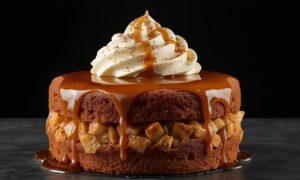PEACH BLACKBERRY TART Have you ever tasted a dessert that feels like summer on a plate?
Sweet. Juicy. Vibrant. That’s exactly what this tart delivers. I still remember the first time I made a PEACH BLACKBERRY TART, a quiet Sunday afternoon, sun pouring through the window, fresh peaches on the counter, blackberries picked that morning. The aroma was magical. The crust turned golden. The filling bubbled with fruit and love.
This isn’t just any tart. It’s rustic yet refined. Simple to make, but full of flavor. The kind of dessert that makes people stop mid bite and say, “Wow.”
In this post, I’ll guide you through every step. You’ll make a buttery, flaky crust from scratch. You’ll blend the soft sweetness of ripe peaches with the tangy pop of peach blackberry tart. We’ll talk texture, flavor balance, and baking tips that bring it all together.
Why choose this PEACH BLACKBERRY TART over other desserts? Because it’s fresh, seasonal, and stunning without being fussy. It brings beauty to the table and joy to every bite.
Expect easy steps. Simple ingredients. No stress. Whether you’re baking for a summer brunch, a cozy family dinner, or just treating yourself this PEACH BLACKBERRY TART is your sweet ticket to success.
Let’s dive into the magic, one slice at a time.
Ingredients That Build Excellence
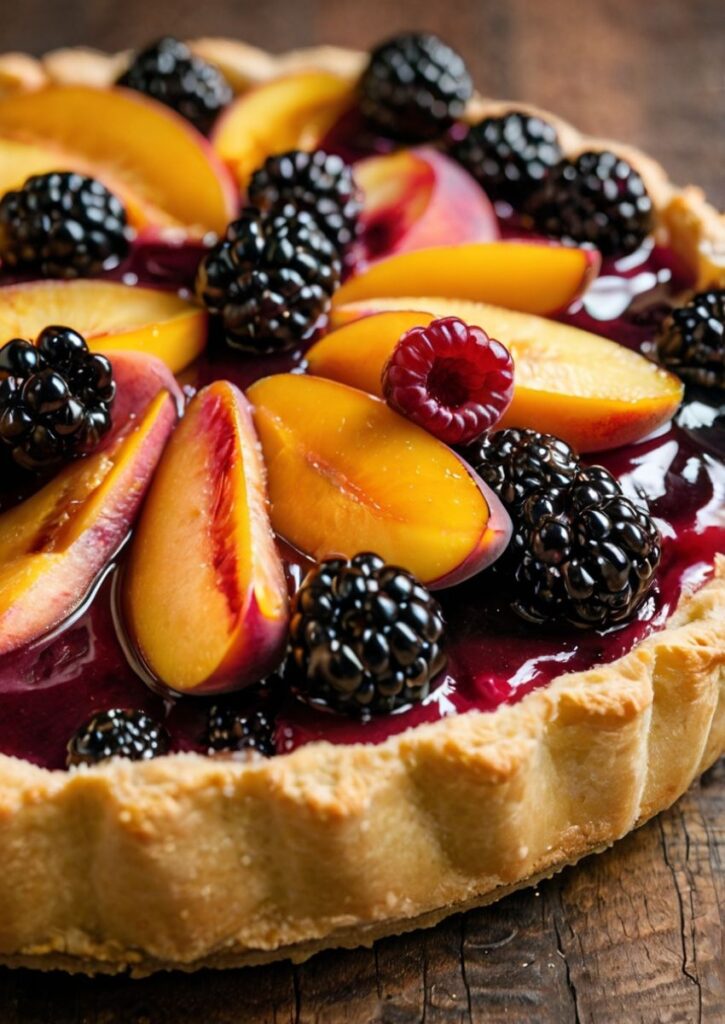
For the Pastry Base:
- 2½ cups all purpose flour (320g)
- 1 cup unsalted European butter, cold and cubed (227g)
- ⅓ cup granulated sugar (67g)
- 1 large egg yolk
- 3-4 tablespoons ice water
- 1 teaspoon vanilla extract
- ½ teaspoon fine sea salt
For the Fruit Filling:
- 6 medium ripe peaches (about 2 pounds)
- 2 cups fresh blackberries (280g)
- ¾ cup granulated sugar (150g)
- 3 tablespoons cornstarch
- 2 tablespoons lemon juice
- 1 tablespoon lemon zest
- ½ teaspoon ground cinnamon
- ¼ teaspoon ground ginger
- Pinch of cardamom
For Assembly:
- 2 tablespoons apricot jam
- 1 tablespoon water
- Pearl sugar for finishing (optional)
Flour choice matters here. All purpose flour gives you tender yet sturdy pastry. European butter contains less water than American varieties. This creates superior lamination and flavor.
Can’t find European butter? Add an extra tablespoon of flour. This compensates for higher moisture content.
Choose your peaches carefully. Freestone peaches slice cleaner than clingstone varieties. Red Haven or O’Henry offer ideal sugar acid balance. The fruit should yield slightly to gentle pressure. Avoid overripe peaches they break down during baking.
Blackberries need attention too. Size matters here. Larger berries contain more seeds. They can overwhelm delicate peach flavors. Oregon grown Marion blackberries work best when available. They offer intense flavor without excessive tartness.
Frozen berries work in winter. Thaw and drain them completely. This prevents excess moisture.
Cornstarch thickens our filling. It creates cleaner gels than flour based thickeners. The amount seems generous, but peaches release significant moisture during baking. Too little starch creates soggy bottoms.
Build Your Foundation: Pastry Mastery
Start with a Solid Base
Start pastry preparation two hours before assembly. Overnight chilling produces superior results. Temperature control separates professional pastry from home disasters.
Cut cold butter into ½-inch cubes. Return to refrigerator. Combine flour, sugar, and salt in a large bowl. Whisk to eliminate lumps. Add butter pieces and work quickly with fingertips. Break fat into smaller pieces without warming.
The mixture should look like coarse breadcrumbs. Some pea sized butter chunks should remain.
Create a well in the center. Whisk egg yolk with vanilla and 3 tablespoons ice water. Pour liquid into the well. Use a fork to gradually incorporate flour mixture.
The dough will look shaggy. This is correct. Won’t hold together when squeezed? Add additional water one teaspoon at a time.
Turn dough onto lightly floured surface. Gather into a rough rectangle. Use the heel of your hand to smear portions of dough away from you. Make quick motions. This technique distributes butter evenly without overworking gluten.
Reform into a disk. Wrap tightly in plastic. Refrigerate at least one hour.
Don’t overwork the dough at this stage. Visible butter streaks are desirable. They create flakiness during baking. The dough should just barely hold together when wrapped.
Rolling requires finesse and proper timing. Remove dough from refrigerator 10 minutes before rolling. It should be pliable but still cold. Roll from center outward in all directions. Rotate frequently to maintain circular shape.
Aim for ⅛-inch thickness. Roughly 12 inches in diameter for a 9-inch tart pan.
Transfer pastry by rolling it around your pin. Unroll over the pan. Gently press into corners without stretching. Stretched dough shrinks during baking. Trim excess, leaving ½-inch overhang. Fold excess under and crimp decoratively.
Blind baking prevents soggy bottoms. Line pastry with parchment paper. Fill with pie weights or dried beans. Bake at 400°F for 15 minutes. Remove weights and parchment. Continue baking until lightly golden, about 8-10 minutes more.
Prepare the Filling for Your Peach Blackberry Tart
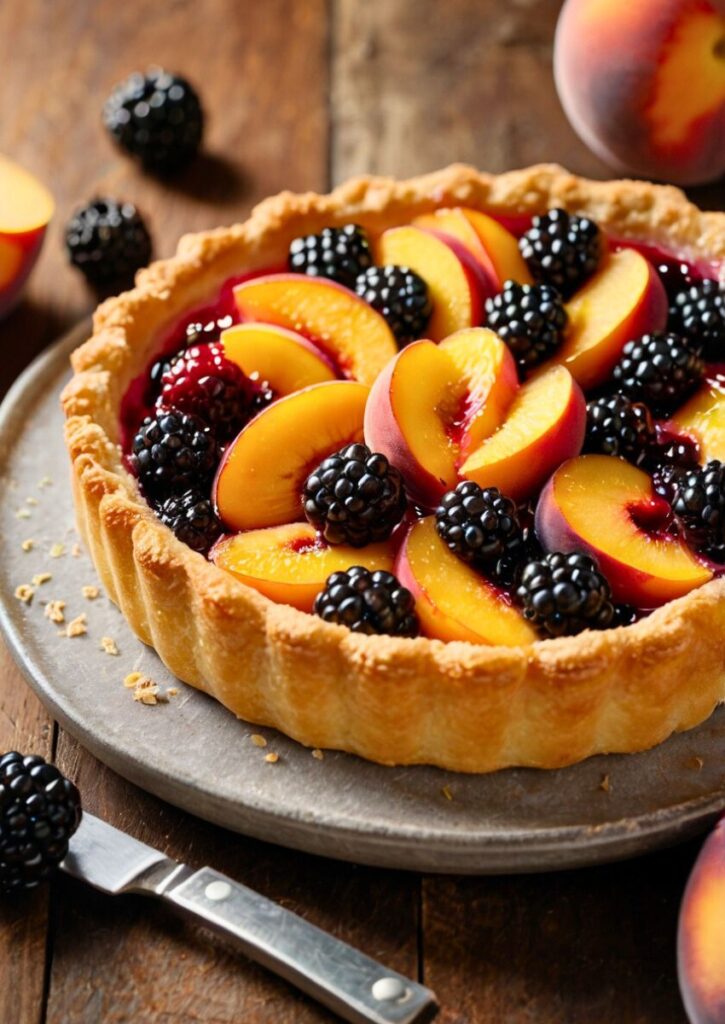
Peach preparation starts with proper blanching technique. Bring a large pot of water to rolling boil. Prepare an ice bath at the same time. Score an X on the bottom of each peach. Make shallow cuts that just break the skin.
Immerse peaches in boiling water for 30-60 seconds. Timing depends on ripeness. Transfer immediately to ice bath using a slotted spoon.
The skins should slip off easily once cooled. Still resisting? Return to boiling water briefly. Peel completely. Slice into uniform wedges about ¼-inch thick. Consistent size ensures even cooking and professional presentation.
Handle blackberries with gentleness. This preserves their structure. Rinse quickly under cold water. Spread on paper towels to dry completely. Wet berries make the filling watery. This compromises both texture and flavor.
Combine prepared fruit with sugar, cornstarch, lemon juice, zest, and spices in a large bowl. The sugar will draw moisture from the fruit immediately. This benefits flavor development but makes timing crucial.
Let mixture stand 15 minutes. This allows flavors to meld. Don’t exceed 30 minutes before baking.
Coat every piece of fruit evenly with cornstarch. Insufficient coating creates pockets of thin liquid. Clumping produces gluey textures. Toss gently but thoroughly with clean hands. This is the most effective method for even distribution.
Assembly: Where Technique Meets Artistry
Preheat your oven to 375°F while preparing the filling. Make sure the partially baked tart shell is completely cool before adding fruit. Warm pastry will begin cooking the fruit too early, affecting texture and structure.
Arrange the fruit in concentric circles, starting from the outer edge. Alternate peach slices with blackberries for vibrant visual contrast and balanced flavor. Pack the fruit snugly but avoid crushing the delicate berries.
The filling will settle slightly during baking, so gently mound the fruit in the center to prevent a sunken appearance.
Brush any exposed pastry edges with cream or a beaten egg. This encourages even browning and adds a professional finish, while also protecting the crust from over browning.
Baking this peach blackberry tart requires attention to detail. Start with a high temperature, 375°F for the first 20 minutes, to set the structure. Then reduce the temperature to 350°F and continue baking for another 25–30 minutes. The filling should bubble actively around the edges, a clear sign the thickening agents are working properly.
Professional tip: If the crust edges brown too quickly, tent them loosely with foil. Avoid covering the entire tart, slight browning on the fruit develops rich, caramelized flavors that elevate the entire dessert.
The Science Behind Perfect Results
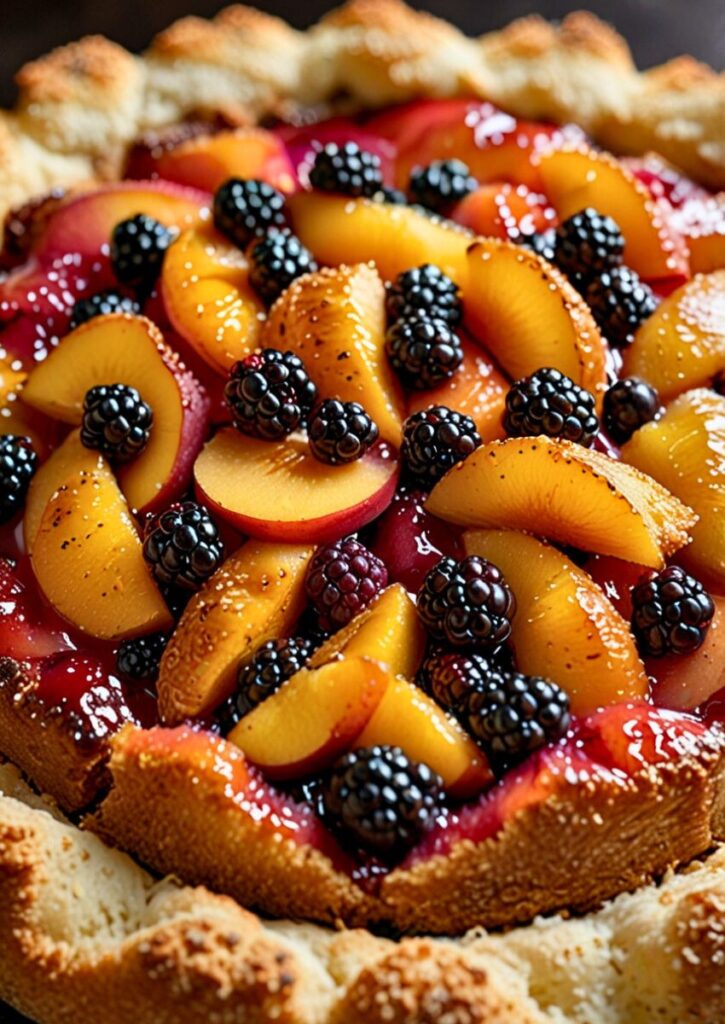
Understanding the science behind a peach blackberry tart turns a good baker into a great one.
The Maillard reaction plays a crucial role here. The natural sugars in peaches begin to caramelize above 300°F, producing deep, complex flavors you can’t achieve otherwise. That’s why accurate oven temperature and careful timing matter so much.
Both peaches and blackberries contain pectin, a natural thickening agent. Blackberries have higher pectin levels, which helps the tart set properly without needing added pectin. Lemon juice not only brightens flavor, it also provides the acid pectin needs to activate.
Steam management during baking is critical. The burst of steam from juicy fruit helps set the cornstarch early, but too much steam trapped in the oven causes soggy pastry. Professional ovens have steam vents; at home, you can crack the oven door slightly in the last 10 minutes of baking to let excess moisture escape.
The cold butter in your pastry isn’t just for flakiness, it’s for steam pockets. As the butter melts and water evaporates, layers lift and separate, creating a tender crust. That’s why keeping butter cold and handling dough gently are rules, not suggestions.
Presentation and Professional Finishing
Cooling your peach blackberry tart properly is the final secret to showstopping success. The filling needs at least two hours to set properly cutting too early results in runny slices that lack professional presentation. Room temperature serving showcases flavors better than chilled tart, though both approaches have merit.
The apricot glaze adds restaurant quality shine while protecting the fruit surface. Heat jam with water until liquid, strain out fruit pieces, then brush lightly over cooled tart. This step transforms home style desserts into bakery worthy presentations.
Garnish options include fresh mint sprigs, edible flowers, or a light dusting of powdered sugar. Pearl sugar scattered over the pastry before baking creates textural contrast and visual interest. Each element should enhance rather than overwhelm the fruit’s natural beauty.
Professional plating involves clean cuts using a sharp knife wiped between slices. Serve on chilled plates with a dollop of crème fraiche or vanilla bean ice cream positioned thoughtfully never overwhelming the tart’s geometric beauty.
Pairing and Service Considerations
Wine pairing elevates the peach blackberry tart from simple dessert to memorable experience. Late harvest Rieslings complement the fruit’s sweetness while providing balancing acidity. Moscato d’Asti offers lighter accompaniment for warm weather service.
For non alcoholic options, consider sparkling water with fresh herbs or lightly sweetened iced tea. The goal is refreshment that cleanses the palate between bites without competing with delicate fruit flavors.
Temperature service varies by season and preference. Summer calls for room temperature tart with cold accompaniments. Winter service might feature warm tart with room temperature cream comfort food elevated through technique.
Leftover tart keeps well covered at room temperature for two days, though the pastry gradually loses its crispness. Professional kitchens often refresh day old tart in a 300°F oven for 5-7 minutes to restore texture.
Troubleshooting Common Issues
If your peach blackberry tart keeps developing a soggy base, prevention starts with proper blind baking and continues with the correct cornstarch ratio. For consistent issues, try baking on the lowest oven rack to improve bottom heat distribution.
Fruit that releases excessive liquid during baking often indicates overripe produce or insufficient thickening agent. Adjust cornstarch upward by one tablespoon if using very juicy fruit varieties. Some professional bakers partially macerate fruit beforehand, draining excess liquid before assembly.
Pastry that shrinks during baking signals overworked dough or insufficient chilling time. The gluten network needs time to relax rushing this step guarantees disappointment. Always chill rolled pastry in the pan for at least 30 minutes before blind baking.
Uneven browning usually results from oven hot spots or improper rack positioning. Rotate the tart halfway through baking and consider investing in an oven thermometer to verify actual temperatures match settings.
Seasonal Variations and Creative Adaptations
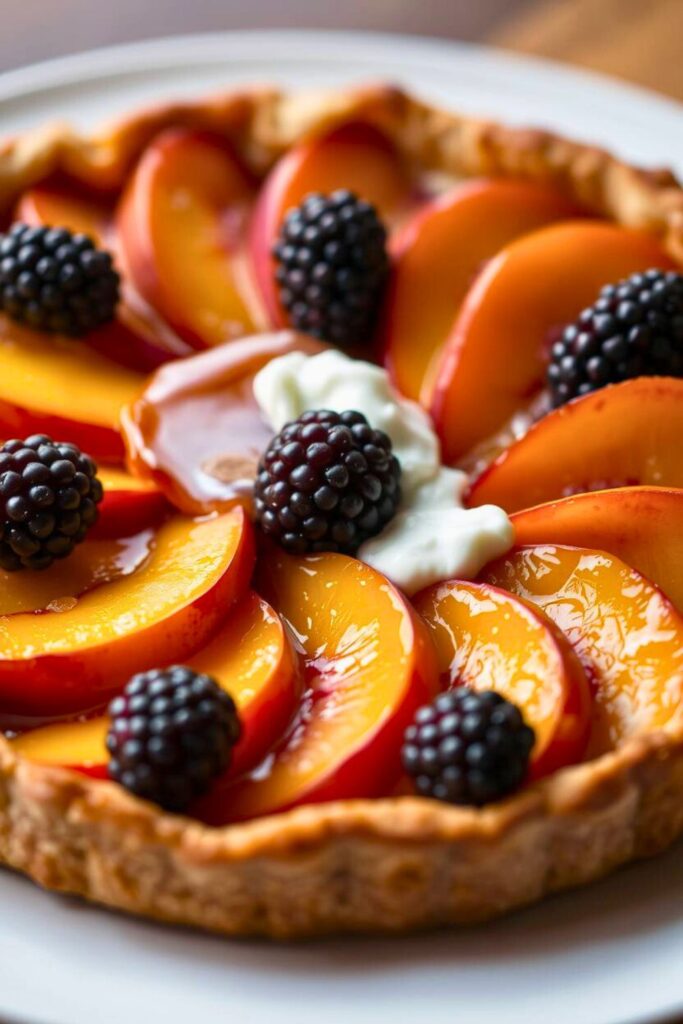
While late summer is peak season for the classic peach blackberry tart, the technique is flexible and adapts beautifully to other fruits and times of year.
In spring, try a tart with strawberries and rhubarb for a tangy sweet contrast. For fall, consider pears and cranberries, which offer warm, earthy tones perfect for cozy gatherings. The key is maintaining the right sugar acid balance and adjusting the thickening agent to account for each fruit’s moisture content.
Professional bakers often create signature twists on the peach blackberry tart by adding flavor enhancing ingredients. A splash of bourbon in the fruit mixture adds sophistication, while a few drops of almond extract in the pastry bring subtle complexity. These touches should complement, not overpower, the fruit’s natural flavor.
Individual mini tarts using 4-inch tart pans are another excellent variation. They offer portion control, elegant presentation, and faster baking, just reduce bake time by 10–15 minutes. The core peach blackberry tart technique remains the same.
For something unexpected, explore savory versions. The same buttery pastry base can carry heirloom tomatoes, herbs, and cheese for a show-stopping summer appetizer. The method transfers perfectly, just swap fruit for veggies and adjust seasonings.
The peach blackberry tart is more than a summer dessert, it’s a versatile canvas for creative, seasonal expression. Whether sweet or savory, the techniques you’ve learned apply across countless variations. That’s the beauty of mastering a great tart: once you understand the foundations, you can create with confidence year round.
Frequently Asked Questions about Blueberry Tart
Q: How far in advance can I prepare the peach blackberry tart?
A: The pastry shell can be blind baked up to two days ahead and stored covered at room temperature. The assembled tart is best served within 6-8 hours of baking for optimal texture, though it remains delicious for up to two days when properly stored.
Q: Can I use frozen fruit in this recipe?
A: Yes, but with modifications. Thaw frozen peaches and blackberries completely, then drain excess liquid thoroughly. Increase cornstarch by 1-2 tablespoons to compensate for additional moisture. The texture won’t be quite as pristine as fresh fruit, but the flavor remains excellent.
Q: Why does my tart filling always turn out too runny?
A: This typically happens due to insufficient thickening agent, overripe fruit, or inadequate baking time. Make sure the filling bubbles actively around the edges during baking this indicates proper thickening. Also check that your cornstarch hasn’t expired, as old cornstarch loses effectiveness.
Q: What’s the best way to prevent the pastry from becoming soggy?
A: Proper blind baking is crucial the shell should be lightly golden before adding fruit. Additionally, ensure your fruit isn’t releasing excess moisture by choosing properly ripe (not overripe) specimens and coating thoroughly with cornstarch.
Q: Can I make individual tartlets instead of one large tart?
A: Absolutely! Use 4-inch tartlet pans and reduce baking time to 20-25 minutes total. Blind bake shells for 8-10 minutes, then add filling and bake another 12-15 minutes. Individual portions cook faster due to their smaller size, so watch carefully to prevent overbrowning.
Final Thoughts on the Peach Blackberry Tart
A well-made peach blackberry tart isn’t just a dessert, it’s a celebration of contrast and craft. The crisp, buttery crust, the sweet-tart fruit, and the balance of rustic charm and elegance all come together in one unforgettable bite. Whether you’re serving it at a summer picnic or a formal dinner, this tart captures the season’s essence with style. Let it be your go-to showcase for fresh fruit and timeless technique, the kind of recipe that turns a quiet afternoon into a delicious memory.
Once you taste the results, you’ll understand why this peach blackberry tart deserves a permanent spot in your baking rotation.
It’s more than a treat, it’s a tradition waiting to happen.
Try it once, and it just might become your signature summer showstopper.

Swiftly Captions by Tina Smith — Quick, flavorful food recipes made simple, bringing fresh inspiration to your kitchen every day





